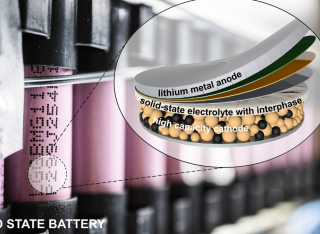
Dr Xuhui Yao
Publications
Solid-state electrolytes have emerged as the grail for safe and energy-dense Li metal batteries but still face significant challenges of Li dendrite propagation and interfacial incompatibility. In this work, an interface engineering approach is applied to introduce an electronic rectifying interphase between the solid-state electrolyte and Li metal anode. The rectifying behaviour restrains electron infiltration into the electrolyte, resulting in effective dendrite reduction. This interphase consists of a p-Si/n-TiO2 junction and an external Al layer, created using a multi-step sputter deposition technique on the surface of garnet pellets. The electronic rectifying behaviour is investigated via the asymmetric I-V responses of on-chip devices and further confirmed via the one-order of magnitude lower current response by electronic conductivity measurements on the pellets. The Al layer contributes to interface compatibility, which is verified from the lithiophilic surface and reduced interfacial impedance. Electrochemical measurements via Li symmetric cells show a significantly improved lifetime from dozens of hours to over two months. The reduction of the Li dendrite propagation behaviour is observed through 3D reconstructed morphologies of the solid-state electrolyte by X-ray computed tomography.
Miniaturized flexible photo-rechargeable systems show bright prospects for wide applications in internet of things, self-powered health monitoring and emergency electronics. However, conventional systems still suffer from complex manufacturing processes, slow photo-charging and discharging rate, and mismatch between photovoltaic and energy storage components in size, mechanics and voltage, etc. Here, we demonstrate a facile inkjet printing and electrodeposition approach for fabricating a highly integrated flexible photo-rechargeable system by combining stable and ultra-high-rate quasi-solid-state Zn-MnO2 micro-batteries (ZMBs) with flexible perovskite solar cells (FPSCs). In particular, Ni protective layer is first introduced into ZMBs to stabilize battery configuration and facilitate enhanced electrochemical performance. The optimized ZMB exhibits ultrahigh volumetric energy density of 148 mWh cm−3 (16.3 μWh cm−2) and power density of 55 W cm−3 (6.1 mW cm−2) at the current density of 400 C (5 mA cm−2), enabling them comparable with the state-of-the-art micro-batteries or supercapacitors fabricated by conventional methods. The embedded FPSCs show excellent photovoltaic performance, sufficient to charge ZMBs and create a self-charging system capable to offer energy autonomy in miniaturized wearable electronics. The integrated systems can achieve an ultrafast photo-charging within 30 s, with sufficient energy to power other functional electronics (e.g., LED bulb and pressure sensor) for tens of minutes. This prototype offers a promising scheme for next-generation miniaturized flexible photo-rechargeable systems.
The constant increase in global energy demand and stricter environmental standards are calling for advanced energy storage technologies that can store electricity from intermittent renewable sources such as wind, solar, and tidal power, to allow the broader implementation of the renewables. The grid-oriented sodium-ion batteries, potassium ion batteries and multivalent ion batteries are cheaper and more sustainable alternatives to Li-ion, although they are still in the early stages of development. Additional optimisation of these battery systems is required, to improve the energy and power density, and to solve the safety issues caused by dendrites growth in anodes. Electrolyte, one of the most critical components in these batteries, could significantly influence the electrochemical performances and operations of batteries. In this review, the definitions and influences of three critical components (salts, solvents, and additives) in electrolytes are discussed. The significant advantages, challenges, recent progress and future optimisation directions of various electrolytes for monovalent and multivalent ions batteries (i.e. organic, ionic liquid and aqueous liquid electrolytes, polymer and inorganic solid electrolytes) are summarised to guide the practical application for grid-oriented batteries.
Irreversible phase transition caused capacity fading has been considered as an obstacle for rechargeable batteries. An in-depth investigation of the irreversible phase transition is critical for understanding the reaction mechanism and developing advanced batteries. In this work, taking vanadium oxide and its alkali ion-stabilized intercalation compounds (A-V-O, A = Li, Na, K) as prototypes, utilizing operando characterizations, we discovered coupled discontinuous (interlayer)-continuous (intralayer) transitions in the stabilized multielectron intercalation cathodes. The highly ordered crystal of vanadium pentoxide irreversibly transfers to a disordered/amorphous structure after the first cycle, whereas A-V-O enables reversible discontinuous lattice transitions at the interlayer pathway for facilitating lithium diffusion. Among the A-V-O family, K-V-O, with the highest capacity retention, shows a coupled discontinuous-continuous transition, which exhibits a continuous transition and the minimum volume change at the V-O intralayer during lithium intercalation/deintercalation. These coupled discontinuous-continuous lattice transitions were captured for the first time in cathode materials. It implies that the suitable ion intercalation induced continuous intralayer transition inhibits the irreversible ion intercalation and phase transition.
Despite the long-established rocking-chair theory of lithium-ion batteries (LIBs), developing novel characterization methodology with higher spatiotemporal resolution facilitates a better understanding of the solid electrolyte interphase studies to shape the reaction mechanisms. In this work, we develop a Xenon ion plasma focused ion beam (Xe+ PFIB)-based characterization technique to probe the cross-sectional interface of both ternary cathode and graphite anode electrodes, with the focus on revealing the chemical composition and distribution underneath the electrode surface by in-depth analysis of secondary ions. Particularly, the lithium fluoride is detected in the pristine cathode prior to contact with the electrolyte, reflecting that the electrode degradation is in the form of the loss of lithium inventory during electrode preparation. This degradation is related to the hydrolysis of the cathode material and the decomposition of the PVDF binder. Through the quantitative analysis of the transition-metal degradation products, manganese is found to be the dominant element in the newly formed inactive fluoride deposition on the cathode, while no transition metal signal can be found inside the anode electrode. These insights at high resolution implemented via a PFIB-based characterization technique not only enrich the understanding of the degradation mechanism in the LIBs but also identify and enable a high-sensitivity methodology to obtain the chemical survey at the subsurface, which will help remove the capacity-fade observed in most LIBs.
Conventional solid-to-solid conversion cathodes in rechargeable aluminium batteries suffer from sluggish reaction kinetics and cumulative structural degradation. Here the authors disclose a solution-to-solid conversion chemistry using molten salt electrolytes to achieve fast-charging capability and good cycling stability. Conventional solid-to-solid conversion-type cathodes in batteries suffer from poor diffusion/reaction kinetics, large volume changes and aggressive structural degradation, particularly for rechargeable aluminium batteries (RABs). Here we report a class of high-capacity redox couples featuring a solution-to-solid conversion chemistry with well-manipulated solubility as cathodes-uniquely allowed by using molten salt electrolytes-that enable fast-charging and long-lived RABs. As a proof-of-concept, we demonstrate a highly reversible redox couple-the highly soluble InCl and the sparingly soluble InCl3-that exhibits a high capacity of about 327 mAh g(-1) with negligible cell overpotential of only 35 mV at 1 C rate and 150 & DEG;C. The cells show almost no capacity fade over 500 cycles at a 20 C charging rate and can sustain 100 mAh g(-1) at 50 C. The fast oxidation kinetics of the solution phase upon initiating the charge enables the cell with ultrafast charging capability, whereas the structure self-healing via re-forming the solution phase at the end of discharge endows the long-term cycling stability. This solution-to-solid mechanism will unlock more multivalent battery cathodes that are attractive in cost but plagued by poor reaction kinetics and short cycle life.
Rational design of the morphology and complementary compounding of electrode materials have contributed substantially to improving battery performance, yet the capabilities of conventional electrode materials have remained limited in some key parameters including energy and power density, cycling stability, etc. because of their intrinsic properties, especially the restricted thermodynamics of reactions and the inherent slow diffusion dynamics induced by the crystal structures. In contrast, preintercalation of ions or molecules into the crystal structure with/without further lattice reconstruction could provide fundamental optimizations to overcome these intrinsic limitations. In this Perspective, we discuss the essential optimization mechanisms of preintercalation in improving electronic conductivity and ionic diffusion, inhibiting “lattice breathing” and screening the carrier charge. We also summarize the current challenges in preintercalation and offer insights on future opportunities for the rational design of preintercalation electrodes in next-generation rechargeable batteries.
Solid-state electrolytes (SSEs) have been thrust into the limelight for the revival of energy-dense lithium metal batteries, but still face the challenge of failure caused by the dendrite penetration. Mounting evidence indicates that dendrite penetration is related to the mechanical failure in SSEs, which calls for mechanical engineering to tackle this problem. This work reports a proof of concept that ion implantation induced surface compressive stress enables resistance in the dendrite penetration. A deterministic sequential multiple ion energies implantation is used to generate compressive stress, with implanted Xe ions distributed in a range of 160-600 angstrom from the surface. The symmetric lithium cells show that pellets with an implantation dose of 10(13) Xe cm(-2) exhibit stable stripping/plating cycles and extended lifespan, while a lower dose of 10(12) Xe cm(-2) cannot create sufficient stress to prevent dendrite penetration, and an excessive dose of 10(14) Xe cm(-2) leads to structural destruction and a decrease in stress. This improved performance is attributed to the induced surface compressive stress balanced over crystal grains, which is confirmed by grazing incidence diffraction techniques. The author's efforts demonstrate the usefulness of surface compressive stress to suppress dendrite penetration, offering more insight into rational stress-strain engineering as opposed to empirical optimization.
High-level safety is of vital importance to the continuous pursuit of high-energy-density batteries in the increasingly electrified world. The thermal instability and dendrite-induced issues of conventional polypropylene (PP) separators often cause internal short circuits and thermal runaway in batteries. Herein, a thermally stable and dendrite-resistant separator (F-PPTA@PP) is constructed using a dual-functional and easy-to-commercialize design strategy of thermally safe poly-p-phenylene-terephthamide nanofibers and plasma-induced lithiophilic fluorine-containing groups. In situ thermal monitoring, in situ optical observation, and multiphysics simulation demonstrate that F-PPTA@PP can suppress thermal shrinkage of the separator and the formation of hotspots, and also promote uniform lithium deposition. Subsequently, lithium metal batteries are assembled, featuring an initial capacity of 194.1 mAh g(-1) at 0.5 C with a low-capacity attenuation of 0.02% per cycle over 1000 cycles. When operating under extreme conditions, i.e., -10 and 100 degrees C, ultrafast charging/discharging rates up to 30 C, lean electrolyte (2.4 mu L mg(-1))/high mass-loading (10.77 mg cm(-2)) or lithium-sulfur batteries, F-PPTA@PP separator still enables competitive electrochemical performance, highlighting its plausible processing scalability for high-safety energy storage systems.
Electronic skins (e-skins), which can seamlessly adapt and adhere to the body to mimic the functionality of human skin, are a rapidly emerging research area. Such e-skins have the potential to revolutionize artificial prosthetics, robotics, human-machine interfacing, and health monitoring applications. Powering the e-skin is a critical challenge at present due to strict performance criteria, including flexibility, stretchability, mobility, and autonomous operation. One of the most promising approaches to overcome some of these challenges is to scavenge energy from the human body's movements and its surrounding environment. This paper outlines some of the key potential developments that enable energy harvesting through mechanical, thermal affects, and low light sources, as well as energy management and storage technologies, which could lead toward the construction of autonomous e-skin modules and self-powered sensing systems.
Voltage plateau is an eigenvalue associated with the electrochemical reaction and hence a feasible tool for real-time detection of the state of charge in batteries. The variation of voltage plateau generally relates to the degradation of batteries, indicating the changes in the structure and/or the composition of electrode materials. In this work, we focus on a voltage plateau variation in a bismuth-potassium cell, investigating the electrode evolutions by two in situ methodologies. The phase transition reveals an intermediate phase in the reaction process, featuring a very limited but constant mass fraction. An irreversible structural collapse that follows leads to the exponential magnifying of the intermediate phase, taking responsibility for the distinct diffraction peaks and new voltage plateaus in the following cycles. This reaction mechanism builds the bridge between voltage plateau variation and electrode evolution, highlighting a combined effect of intermediate phase and structural collapse.
